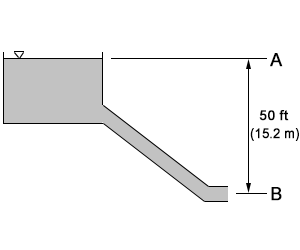For reference, the Bernoulli equation is:
$latex E_t = E_p + E_v + E_z\newline
\indent =\frac{p}{\rho}+\frac{v^{2}}{2}+zg\hspace{20px}^{(SI)}\newline
\indent =\frac{p}{\rho}+\frac{v^{2}}{2g_c}+\frac{zg}{g_c}\hspace{20px}^{(US)}&s=2$
Example 1
A reservoir contains an outlet that consists of a pipe that discharges water 50 ft below the top of the reservoir.
What is the velocity of the water exiting the pipe (at point B)?
Solution
If you define elevation zero at point B:
- Point A has only potential energy
- Point B has only kinetic energy
The Bernoulli equation states that total energy must be the same, therefore:
| U.S. Units | Metric |
|---|---|
| $latex E_{tA} = E_{tB}\newline\newline 0 + 0 + \frac{z_A g}{g_c} = 0 + \frac{v_B^{2}}{2g_c} + 0\newline\newline\frac{(50 ft)(32.2 ft/s^{2})}{32.2 \frac{lbm\cdot ft}{lbf\cdot s^{2}}} = \frac{v^{2}}{2(32.2 \frac{lbm\cdot ft}{lbf\cdot s^{2}})}\newline\newline\newline v = 56.7 ft/s&s=2$ | $latex E_{tA} = E_{tB}\newline\newline 0 + 0 + z_A g = 0 + \frac{v_B^{2}}{2} + 0\newline\newline (15.2 m)(9.81 m/s^{2}) = \frac{v^{2}}{2}\newline\newline\newline v = 17.3 m/s&s=2$ |
Example 2
A pump is pumping water up a hillside into a reservoir. The pump rate is 4 ft/s (1.22 m/s) with a pressure of 100 psi (689 kPa). What is the maximum elevation of the reservoir that the pump can handle? (Water = 62.4 lbm/ft3 or 1000 kg/m3).
Solution
- The pump has both pressure and kinetic energy
- The reservoir has only potential energy
According to Bernoulli’s principle, the sum of the energy must be the same at both locations.
| U.S. Units | Metric |
|---|---|
| $latex E_{t\cdot pump} = E_{t\cdot reservoir}\newline\newline \frac{p}{\rho} + \frac{v^{2}}{2g_c} + 0 = 0 + 0 + zg_c\newline\newline \frac{100 psi}{62.4 lbm/ft^{3}} + \frac{(4 ft/s)^{2}}{2(32.2 \frac{lbm\cdot ft}{lbf\cdot s^{2}})}= \newline\newline \hspace{50px}= \frac{z\cdot (32.2 ft/s^{2})}{32.2 \frac{lbm \cdot ft}{lbf\cdot s^{2}}}\newline\newline\newline z = 231.0 ft&s=2$ | $latex E_{t\cdot pump} = E_{t\cdot reservoir}\newline\newline \frac{p}{\rho} + \frac{v^{2}}{2} + 0 = 0 + 0 + zg\newline\newline \frac{689 kPa}{1000kg/m^{3}} + \frac{(1.22 m/s)^{2}}{2}= \newline\newline\hspace{50px}= z\cdot (9.81 m/s^{2})\newline\newline\newline z = 70.3 m&s=2$ |

Speak Your Mind